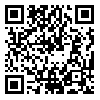BibTeX | RIS | EndNote | Medlars | ProCite | Reference Manager | RefWorks
Send citation to:
URL: http://nmj.umsha.ac.ir/article-1-1579-en.html
Introduction: There is limited research on the relationship between burnout and aggression (as a reaction to burnout and not personalities). In this study, this relationship was investigated with the presented model. This study focused on the relationship between aggression and burnout by using regression analysis to determine the predictors of aggression.
Methods: In this analytical study, using simple random sampling and with the help of Cochran, about 82 of the nurses of internal, surgery, emergency, psychiatric, ICU, and CCU section were selected at social security hospital in zahedan, as the minimum required sample. The study was conducted during January 2016, and a questionnaire was completed by all candidates. The study tool was a standard questionnaire in three parts, including demographic, Maslach burnout dimensions (1997), and of Buss and Perry (1992), and evaluated the reliability and validity, and distributed among the sample. To analyze the data, Pearson correlation test and Friedman test, using the SPSS software and Smart PLS software, were used for two-stage partial least squares method and structural equation model to analyze the assumptions, confirmatory factor analysis and path analysis.
Results: According to the path factors, the significance was determined at P value=0.01 for burnout and its dimensions, including anger (sig=0.001, Reg=-0.599), aggression (sig=0.001, Reg=0.433) and hostility (sig=0.001, Reg=0.364). Also, the burnout dimensions, including depersonalisation (sig=0.001, Reg=0.419), emotional exhaustion (sig=0.01, Reg=0.189) and feelling of ineffectiveness (sig=0.01, Reg=0.234) had similar effects on aggression. The results showed that depersonalization has the greatest impact on aggression. On the other hand, according to Friedman test results among burnout dimensions, emotional exhaustion among nurses of this hospital was the most significant. Also, burnout had an indirect effect on anger.
Conclusions: In order to control the interaction between burnout and aggression and also their dimensions, the booster conditions of working and environmental mental health must be improved and restrictive conditions of burnout as independent and effective variables and aggression consequently prepared in the organization.
Received: 2016/07/23 | Accepted: 2016/08/26 | Published: 2017/01/30
| Rights and permissions | |
 |
This work is licensed under a Creative Commons Attribution-NonCommercial 4.0 International License. |






 gmail.com
gmail.com